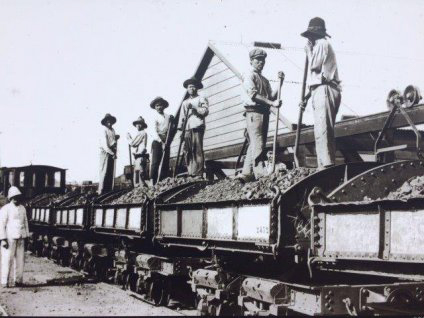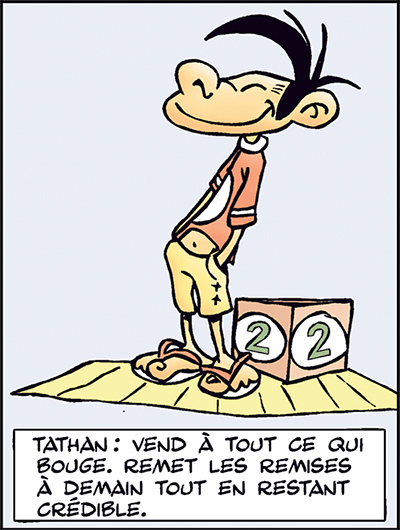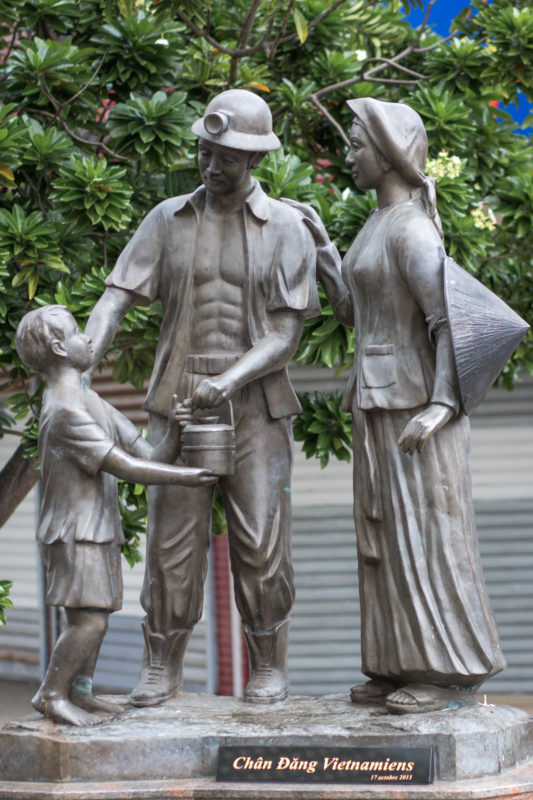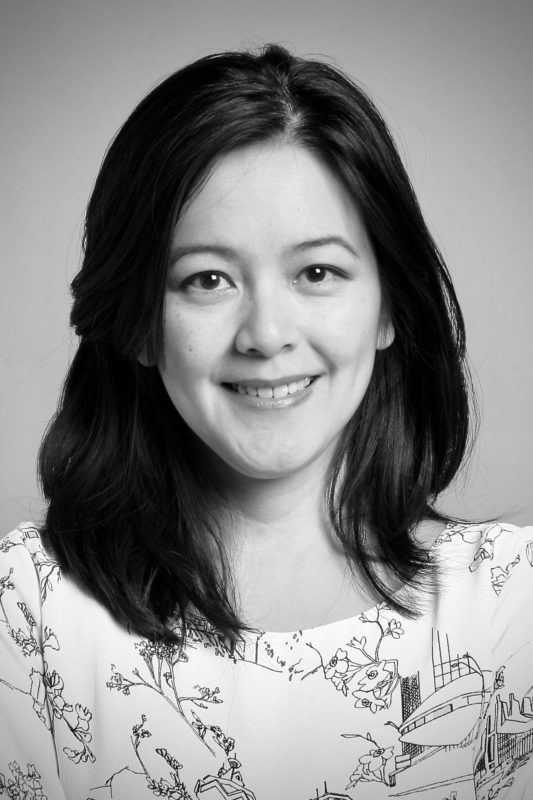“Where are you from?” This is a question you’ve probably been asked often as a Vietnamese immigrant living in the US. For me, arriving as a teenager in North Hollywood, the epicenter of valley girlhood in California, it was a common question I heard from Americans as much as from Vietnamese Americans. Befuddled by this existential query, I would reply: “I’m Vietnamese, I came from New Caledonia, and I’m French too.” A blank stare would reflect back at me as if a strange bird had just landed on the porch of their mind.
There is a missing chapter in the history of the Vietnamese diaspora that explains my cryptic answer. And I only found out myself about the details of this history a few years ago.
I came to New Caledonia from Vietnam when I was six, not as part of a wave of immigrants, but as a result of economic migration – someone in my family thought it would bring better opportunities. Before heading to school, I stared out every morning at the Pacific Ocean from my house balcony, squinting past the billowing white smoke from the nickel processing plant to the reef, thinking to myself: how did I get here? I don’t belong here. What will become of me on this forsaken island in the middle of nowhere?
What I wish I had known then was that the first generation to leave Vietnam for New Caledonia, like me, actually came much earlier. This is a brief history of this community that is dear to me – the “Chân Đăng,” the Vietnamese who settled on the French island of New Caledonia at the end of the 19th century. Their experiences highlight a dark chapter in France’s colonial rule and its difficult decolonization process, which still unfolds today. Their untold, harrowing journey to “make it” in their new country highlights the common traumas we hold on to and the questions of identity we share in the diaspora across geographies and across generations.
They Came to New Caledonia as Contract Workers
Tucked away in the heart of the South Pacific, New Caledonia is the postcard picture of a dream beach destination. Surrounded by an impossibly azure blue lagoon declared a Unesco World Heritage site, this French territory was nicknamed “the island closest to paradise” by a Japanese writer. A visitor from Switzerland once described it to me as “Paris with a beach,” referring to France’s strong political, economic and cultural hold on the island since 1853.
The story of modern New Caledonia begins in 1864 with French prisoners being exiled there from their European and African homelands. It also begins with Vietnamese workers who came to the island starting in 1891 as contracted laborers working in the island’s nickel and chromium mines, which helped establish France as a trading nation.

Nickel ore is a key component for making stainless steel, and New Caledonia holds up to 25% of the world’s nickel reserve. Back when nickel boomed in 1873, the French colonists – les colons – needed workers to extract this green-hued ore from the mines, and they didn’t get along well with the native Melanesians – les Kanaks – who occasionally revolted against French colonial rule. The French sent word to their fellow colonists in Vietnam and other French-occupied countries to recruit laborers. In Tonkin, Northern Vietnam today, men and women struggled to survive as French forces took control of the region. The pitch of guaranteed pay for five years and 1.5 pounds of rice per day on a French island was an easy sell. Laborers could send back money to feed their families. The savings might even be enough for them to buy small rice paddies when they returned to their villages, which could save their large families from famine. As many recruits were illiterate, they hastily signed the five-year contract and boarded the ship, only to realize, this “island of hope” was not all that they dreamed of.
In 1891, about 790 Vietnamese, including 50 women, arrived in New Caledonia on a ship named Chéribon. Upon arriving, those who survived the month-long trip were matriculated as a number on their new identification papers, because their names were deemed too difficult to pronounce. They nicknamed themselves Chân Đăng, hired feet or, some would say, chained feet. A typical day began at 5 am and ended after sundown, sometimes with no water break, and with half the promised daily ration of rice. With more work than labor available, their overseers resorted to whipping and other corporal punishment. The workers could not leave their designated area without legal permission; rebellion was unthinkable. Despite these slave-like conditions, more Vietnamese workers continued to arrive through the 1930s, along with Indonesians and Japanese. During World War II, France dissolved most agreements with Indochina and the Chân Đăng could no longer return home. In June 1945, the French government released all laborers from their contracts.

American GIs in New Caledonia and the Rise of the Vietnamese Middle Class
Effectively exiled from their homeland, many Vietnamese workers chose to move to Nouméa, the capital city located 250 miles south of the nickel mines. With meager savings, they bootstrapped new businesses: laundries, tailors, bazaars, retail shops and restaurants. In late 1941, after the Japanese attacked Pearl Harbor, the US and the Allied forces shifted their military resources to fight their enemy in the South Pacific. Located between the United States and Australia, and protected by a barrier reef, New Caledonia became the ideal spot for the US Navy fleet base.
From 1942 to 1946, one million American soldiers passed through Nouméa, at times outnumbering the locals. The GI’s brought to the island jazz, GMC cars, chewing gum, and Coca Cola, hurling this sleepy town into modernity. Entrepreneurs, including some Vietnamese, flourished from their presence – restaurants, bars and stores bourgeoned overnight.
Reversed Exile: The First Generation Born in New Caledonia are Forced to Leave for Vietnam
This era of prosperity and happiness was short-lived. In May 1954, the battle of Điện Biên Phủ in Northern Vietnam gave hope to the Chân Đăng that Vietnam could become independent and that they might be able to return to their homeland. In 1956-1958, an anti-Asian wave swept through the world, including in New Caledonia. Vietnamese became the target of anti-Viet campaigns from the French government with slogans like “Buying from Vietnamese is betraying France,” and “Vietnamese, out!” Eventually, all Chân Đăngs were asked to leave.
For the first time, the Vietnamese community in New Caledonia split in two ideological camps: those who identified with the victorious fighters in Northern Vietnam and wanted to return home, and those who sided with the French, for they feared being persecuted as Catholics moving back to a now-Communist regime. Unwelcome on the island, many Chân Đăngs left for Vietnam between 1960-1964.
With their prized wage savings and any furniture they could haul on the ship, they boarded the Eastern Queen with their children born in New Caledonia. This second generation was unwillingly deported to a “homeland” they had never known. They left behind their first country, their friends and their Western way of life. In an effort to undo the traumas of moving away from Vietnam, the Chân Đăngs essentially passed on the traumas of displacement to their own children. Some of the older kids, like writer Jean Vanmai, hid in the city or jumped ship to escape from being sent to Vietnam. By 1963, fewer than 1,000 Vietnamese remained in New Caledonia.
On Reconciliation and Assimilation
How many generations does it take for immigrants to feel fully assimilated? Does it sometimes never happen?
Starting in 1946, the Kanaks and non-white settlers, including the Vietnamese in New Caledonia, gained French citizenship, which allowed them to vote in local as well as French elections. They were allowed to attend French schools a year later, which helped them eventually access white collar jobs. Gradually, they integrated in the general population. A Vietnamese association was formed to encourage relations with Vietnam and to preserve Vietnamese traditions including Tet.

Today, a bronze statue commemorating the first Vietnamese in New Caledonia stands by the newly erected Chinese gate which marks Chinatown in Nouméa, where Chân Đăng descendants, along with recent Vietnamese and Chinese immigrants, run bazaar shops offering clothing, textiles, and food.

In 2013, a group of surviving Chân Đăng who were sent to Vietnam came back for an emotional visit to New Caledonia for the first time, and probably their last, after 50 years of being exiled.
Today, there are about 2,300 Vietnamese living in New Caledonia, which represents 1% of the island’s population, but that doesn’t account for those who identify as mixed race. My family is part of this 1%, but their kids, the next generation, are probably not counted in this number because they are all of mixed race. It’s hard to tell the difference between children of more recent Vietnamese immigrants and those who are fourth- or fifth-generation descendants from the Chân Đăng.
In the minority of a minority group, how do we define our identity? I suppose we are Viet⋅ish: Phở-eating, éclair pastry-gobbling and wine-loving, we grew up on a media diet of French variety shows, Japanese imported cartoons and US main staples like 80s soap operas Dallas and Dynasty, and now Game of Thrones and Star Wars. While that doesn’t fit your typical US profile of Vietnamese immigrants, this is who Vietnamese New Caledonians are.
In a Country Where the Native People Want Independence from France, Where Do Vietnamese Belong?
Where do our allegiances belong politically? In early November 2018, New Caledonians were explicitly asked to answer in a referendum vote: “Do you want New Caledonia to gain full sovereignty and become independent?” 56% voted to remain a French territory, the closest vote to date. While it’s easy to paint this as a black vs. white vote, the reality in New Caledonia is a rainbow of reactions for the 5% of the population who are Indonesian, Vietnamese, Wallisian, Tahitian, and Martiniquais.
For many non-natives, including Vietnamese, voting to remain French minimizes the potential of being displaced or exiled. It’s also because non-Kanak ethnic groups who have lived for generations in New Caledonia have no viable option – at least not yet – to remain in the country under self-rule even if they have more common history with the native Kanaks. While speaking up politically is still a mixed bag for Vietnamese in New Caledonia, one Chân Đăng descendant, André Dang, has blazed the trail by finding his own voice in politics and in the local economy. “My parents didn’t have names, they had numbers. My father died in the mines,” Mr. Dang recalls. “The Kanaks were excluded like us in the past.”
André Dang, the Mining Magnate You Don’t Know
André Dang was born in the nickel mine settlements of the Chân Đăng. His father died there when Mr. Dang was just seventeen months old. His mother, who also started as a contract worker, raised him and two other children on her own in New Caledonia, after having left three kids in Vietnam before coming to the island. Mr. Dang rose from the nickel mine dust, defying many obstacles, built an auto dealership /gas station / real estate empire from nothing, and he didn’t stop there. In his 50s, he made a promise to his friend, Jean-Marie Tjibaou, the most prominent political and cultural Kanak leader of the independence movement. Mr. Dang promised to help Mr. Tjibaou and his political party take ownership of mine lands from the French and develop them so as to help advance their economic independence. Mr. Dang found himself back in the mining industry, this time as an executive and chief negotiator for the Kanaks.
Without doubt, his story as a self-made entrepreneur-turned-mining magnate belongs in Forbes magazine. What’s most intriguing about him is how he found the audacity to speak in his own voice as a quiet yet pragmatic advocate of New Caledonian independence with economic sustainability. More than once called a Viet Cong by the French-controlled local media, Mr. Dang was also accused by the newspaper Le Point of financing the Kanaks in their independence efforts. Enflamed by this article, angry French loyalists burned down his auto dealership and gas station in 1985, forcing him into exile in Australia for six years.
Mr. Tjibaou was assassinated in 1989, but Mr. Dang kept the promise he made to his friend to return to New Caledonia and help the Kanaks build their own nickel mine. In the mid 90s, Mr. Dang negotiated a complex set of land deals and financing to build a mining processing plant in which the Kanak-owned entity controlled 51% of the business venture with a Canadian mining group, an unprecedented feat in New Caledonia’s colonial history. Mr. Dang runs the mining company, SMSP, as President and Chairman to this day, at the age of 82. Jean-Marie Tjibaou’s son, Emmanuel, affirms, “Before [Dang], the economy, it was a thing for the Whites.” In other words, an outsider – an immigrant – became an integral part of the nation’s history.
Why Does Vietnamese Diaspora History Matter?
I tell this story because, as a parent now, raising girls in America, I understand the power of representation, especially in the media and in politics. And representation starts with placing us in history.
Why does representation matter? For Vietnamese kids who left Vietnam but weren’t part of the large migration wave to the US after the fall of Saigon in 1975, who went to New Caledonia, New Hebrides (now Vanuatu), Canada, France, West Germany, the Philippines, even Norway, we are like seeds spread by the winds that sprouted and learned how to thrive without anyone knowing what to name us. We are part of the Vietnamese diaspora, but we have yet to name ourselves.
There was only one other Vietnamese girl in my elementary school, and we became friends, not because we liked each other, but because we wanted to know we were not alone in the world, and we needed someone to see us, tell us our experience matters – we matter. Understanding the history of the Chân Đăng, those who came before me would have helped me explain why Vietnamese dishes like “porc au sucre” – the local version of thit kho, or caramelized pork – is as popular as “steak frites” on the island , or that “nem” – a longer version of the egg roll – is sold at most snack bars downtown and on the beach. If the history of Vietnamese in New Caledonia had been written in school books, it would have made it easier to speak up when I was called a “Chinetoque” in school, the equivalent of “chink” in English. This is why the Chân Đăng belong in the history of the Vietnamese diaspora, as do the Vietnamese of New Caledonia.
A French translation of this essay is available here.
Contributor Bio
 Helene Dina was born in Vietnam and grew up in New Caledonia. She immigrated to the US as a teenager. She is passionate about exploring topics surrounding post-colonialism, feminism, technology, travel and food. Helene is a business consultant who provides strategy and operations help to Fortune 500 companies in technology, media and consumer packaged goods. Helene holds a B.A. in economics from UC Berkeley and an M.B.A. from Harvard Business School. She lives with her husband and young children in Los Angeles. Twitter: @helene_dina
Helene Dina was born in Vietnam and grew up in New Caledonia. She immigrated to the US as a teenager. She is passionate about exploring topics surrounding post-colonialism, feminism, technology, travel and food. Helene is a business consultant who provides strategy and operations help to Fortune 500 companies in technology, media and consumer packaged goods. Helene holds a B.A. in economics from UC Berkeley and an M.B.A. from Harvard Business School. She lives with her husband and young children in Los Angeles. Twitter: @helene_dina



Excellent writing!
Great article on the Vietnamese experience in Nouvelle Caledonie- howver,you left out mentiin of the Vietnamese who also went to AUSTRALIA after 1975- I grew up in Australia’s far north where I went to school with many Vietnamese who were of that generation,plus Australia’s major cities like Sydney,Melbourne and Brisbane have alwats similarly had large Vietnamese populations since the end of the Vietnam War
To the reader,
I’m a Nippokanakocaldoche man (meaning Caledonian with Japanese, Kanak and French ancestry for those who wonder), born in the eighties in New Caledonia, now living in Paris.
While reading this article, it was as if a member of my family was telling me a story… this story with those chosen words that one would want to tell one’s own children. Those words that may help to behave and to be. I think Shakespeare was wrong. To be is the question.
Merci pour le partage.
Ps. after reading I discovered there was French version.
Thank you Helene for writing about this part of your life. I recently discovered Nouvelle Caledonie in my french class and plan to read and explore more on this island. Mainly, I want to learn more about Vietnamese who immigrated to Nouvelle Caledonie. The Vietnamese Diaspora in NC is so fascinating to me. Great job!
VR
Hieu Thai
Thank you for an absolutely fascinating article. I am currently on holiday in Nouméa and having lived on a big island like Australia for the past 40 years, I thought surely there wouldn’t be any Vietnamese living on a tiny little island like this. Was I wrong, first day and I already found three restaurants and two grocery stores. Your article filled the gaps for me. The story of New Caledonia is interesting but the story of the Vietnamese people living here is even more so.
Thank you, Linh!
Thank you for sharing your history with us, Helene. Growing up, we knew a Vietnamese family from New Caledonia who ran a bakery in South OC. I was fascinated by this and since then, I have been wanting to visit the island.
Thank you!
Hi Hélène, this is an eye-opening article about the Vietnamese community that I did not know existed. Thank you for sharing your experience and giving us the rich history. I’m not surprised of Andre Dang’s success and his difficulties. I would love to visit New Caledonia in the near future and hope to connect with you. [email protected].
This is my story: https://medium.com/@lucyha93/in-vietnam-the-ghost-of-agent-orange-still-looms-large-850fac1ad9a2
Thank you, Trinh.
A brief yet comprehensive history of a little-known part of the Vietnamese diaspora. I sense a compelling story behind each of the people who came to New Caledonia. Can’t wait to read your next articles.
Thank you, Worldwanderer! That’s so kind.
Thank you, Natalie.
This is super interesting. I’d love to chat more! My research is on Vietnamese refugees that resettled in spaces with active decolonization movements, such as Guam and Israel-Palestine. New Caledonia sounds really relevant to this narrative. Thanks for sharing!
Hi Evyn, this is Helene Dina. Thanks for your message. I’m happy to chat more. DM me on Twitter @helene_dina to get in touch.
I definitely didn’t know about this part of history even though my relatives live in New Caledonia. Great job capturing history on the island!!!
Thank you, Anh!
Thank you so much for sharing this fascinating history, which I did not know about before reading this article.
Thank you, Natalie.
Thank you so much for this fascinating history, which I was not aware of until I read this article.